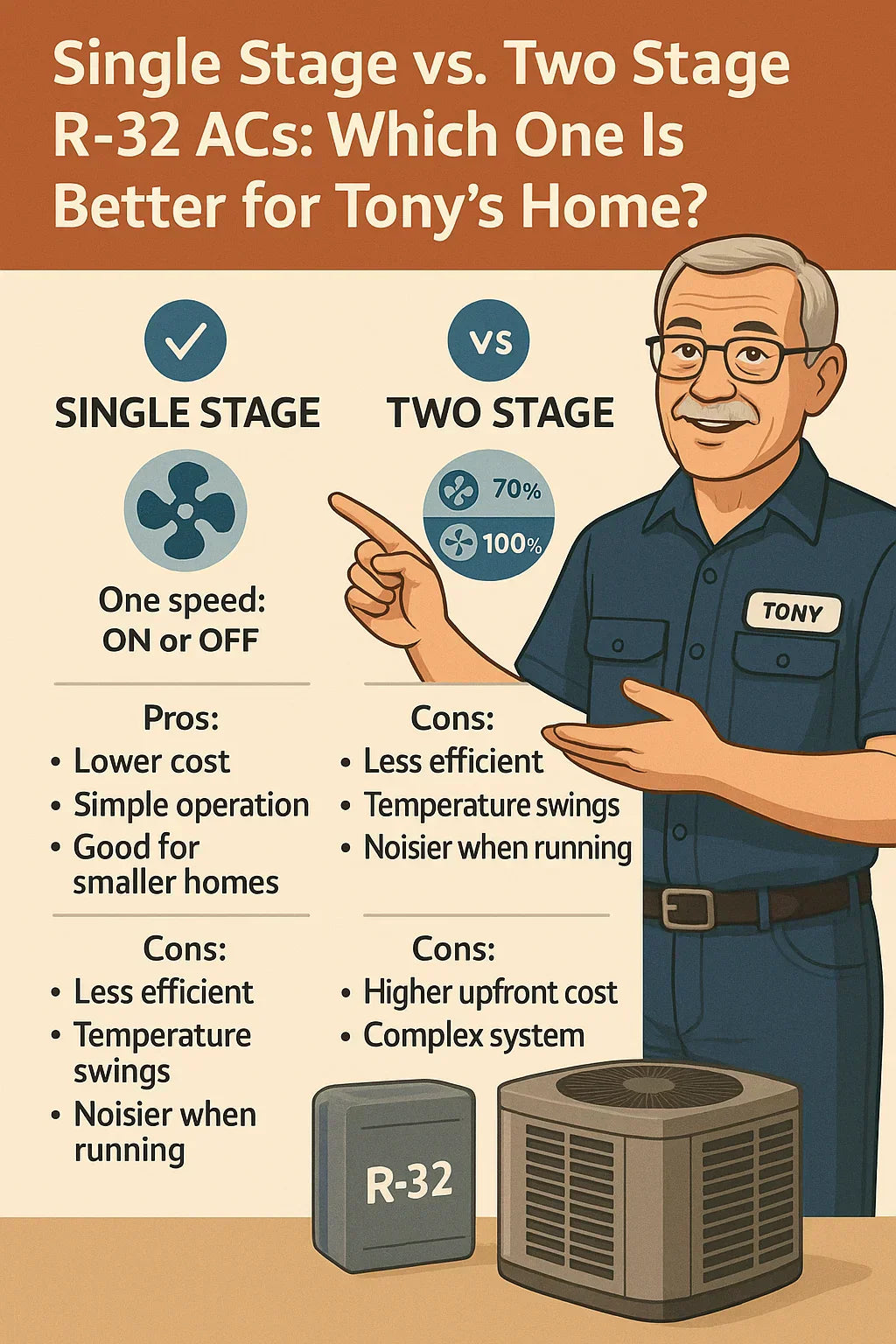Introduction: Why This Decision Matters
Tony's current AC system is nearing the end of its life, and with R-32 refrigerant gaining traction in 2025, he's now deciding between a single-stage and two-stage R-32 AC. While both types offer cooling comfort and modern energy efficiency, the stage of compression can impact everything from upfront cost to monthly energy savings, humidity control, and system longevity.
This guide breaks down the differences between single-stage and two-stage R-32 air conditioners—what they mean, how they perform, and which is best for Tony’s home and budget.
1. What Does “Stage” Mean in an AC System?
✅ Single Stage:
-
Compressor runs at full capacity whenever it’s on.
-
Only one mode: 100% ON or OFF.
-
Simpler control, basic comfort, lower cost.
✅ Two Stage:
-
Compressor can run at two levels—typically 100% and ~70%.
-
More precise control.
-
Adjusts cooling output based on your home’s real-time needs.
✅ Why It Matters for R-32 Units:
R-32 refrigerant is more efficient and eco-friendly than R-410A. Paired with a two-stage compressor, it can dramatically improve SEER2 performance, humidity control, and energy savings.
2. Upfront Cost Comparison: Which Is More Affordable?
| Feature | Single-Stage R-32 AC | Two-Stage R-32 AC |
|---|---|---|
| Unit Cost (2025) | $2,300–$3,200 | $3,300–$4,800 |
| Installation | ~$1,500–$2,000 | ~$2,000–$2,800 |
| Total Installed Cost | $3,800–$5,200 | $5,300–$7,600 |
✅ Tony’s Consideration: If he’s upgrading on a tight budget, a single-stage unit may make more sense—but only if comfort isn’t being sacrificed.
3. Comfort Control: How Much Does Tony Value Stability?
-
Single-stage systems cool the home quickly but cycle on/off frequently. This can cause temperature swings and higher humidity during summer.
-
Two-stage systems run at lower speed most of the time, offering:
-
More consistent temperatures
-
Lower humidity (great for hot, sticky climates)
-
Quieter operation
-
🛠️ Example:
Tony lives in Atlanta, where summers are humid. A two-stage system would better manage moisture levels while keeping the home cool more evenly.
4. SEER2 Ratings: Where Efficiency Meets Real Savings
Average SEER2 by System Type:
-
Single-Stage R-32 AC: ~14.3–15.2 SEER2
-
Two-Stage R-32 AC: ~15.2–17.5 SEER2
🔍 Higher SEER2 = Lower energy bills.
Real-World Savings:
Let’s say Tony spends $200/month on electricity in the summer:
-
A single-stage system might shave off 10–15%.
-
A two-stage system could cut costs by 20–25%, especially if paired with a programmable or smart thermostat.
5. Maintenance & Longevity: Is It Worth Paying More?
| Metric | Single-Stage | Two-Stage |
|---|---|---|
| Complexity | Simple | More advanced |
| Maintenance Cost | Lower | Slightly higher |
| Expected Lifespan | 12–15 years | 14–18 years |
| Repair Costs | $250–$600 typical | $400–$900 typical |
✅ A two-stage unit may last longer due to fewer on/off cycles—but if something breaks, repairs can cost more.
6. Noise Levels: How Quiet Is Each Option?
-
Single-Stage: Turns on at full blast, often louder.
-
Two-Stage: Runs at lower speeds most of the time—noticeably quieter.
🎧 If Tony’s bedroom is close to the outdoor condenser, he’ll likely appreciate the lower decibel rating of a two-stage system.
7. HVAC System Compatibility
-
Single-stage units work with any basic thermostat and duct system.
-
Two-stage units often benefit from upgraded thermostats (smart or communicating models).
-
Ducting should be sealed and efficient to prevent performance loss in either system.
✅ If Tony’s existing ducts are well-maintained and he’s open to a smart thermostat, two-stage is an easy fit.
8. Tax Credits and Rebates (2025)
-
Many two-stage R-32 units with SEER2 ≥ 15.2 qualify for:
-
Federal Energy Efficiency Tax Credits (up to $2,000)
-
Local municipal incentives
-
🎯 Tony should verify the model’s eligibility at Energy Star or check The Furnace Outlet’s rebate guide.
9. When a Single-Stage R-32 AC Makes Sense for Tony
-
Tony lives in a mild climate (e.g., Pacific Northwest)
-
Budget is the top priority
-
He rarely uses AC or has a small home (~1,000 sq ft or less)
-
He already has a smart thermostat for basic scheduling
10. When a Two-Stage R-32 AC Is the Better Choice
-
Tony wants maximum comfort in hot, humid summers
-
His home is 1,200–2,000 sq ft
-
He runs AC for 5+ months/year
-
He’s staying in the home long-term (10+ years)
-
He wants to reduce energy bills and take advantage of rebates
Conclusion: So, What Should Tony Choose?
If Tony’s looking for value upfront, a single-stage R-32 system gets the job done.
But if comfort, quiet performance, and energy savings matter most—especially in a humid climate—a two-stage R-32 AC offers better real-world returns, better SEER2 ratings, and long-term value.
📌 Key Takeaways
| Factor | Single-Stage | Two-Stage |
|---|---|---|
| Cost | Lower | Higher |
| Comfort | Basic | Superior |
| Efficiency (SEER2) | 14.3–15.2 | 15.2–17.5 |
| Noise | Louder | Quieter |
| Humidity Control | Minimal | Excellent |
| Rebates | Limited | More likely |
| Best for | Budget installs | Long-term investment |
In the next topic we will know more about: R-32 System Maintenance Guide: Filters, Coils & Seasonal Care for Long-Term Performance







